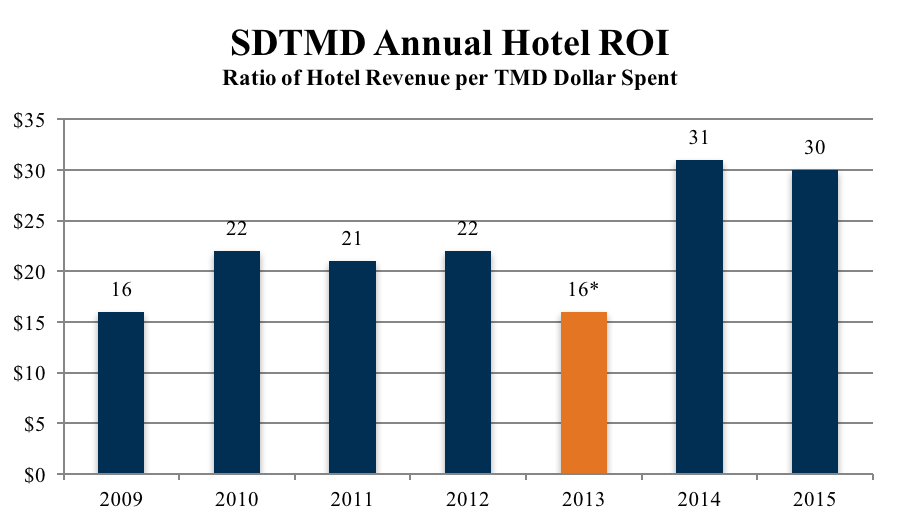The Challenge
San Diego is among the most popular destinations in the world. With shining beaches, a vibrant dining scene, rich nightlife, and every kind of attraction imaginable, the city is a vacationers paradise.
Like most California cities, in the 1960s San Diego implemented a transient occupancy tax (TOT), a tax on hotel guests. Although the initial intention of the TOT was to fund marketing programs, the funds were not protected from redistribution. Over the years, the portion of TOT dedicated to marketing dropped, even as collections grew. In 2003, $13.9 million was dedicated to marketing, but by 2006 that number had dropped to $8.8 million. Yet in the same time period TOT collections grew from $121 million to $128 million.
Recognizing the effects of the dwindling marketing efforts, the San Diego Lodging Industry Association (LIA) began seeking alternate funding sources. They turned to the 36 tourism business improvement districts then in the state as a model. Over the next three years, discussions between hoteliers, the City, and the San Diego Convention and Visitors Bureau (ConVis) brought about creation the San Diego Tourism Marketing District.
The Innovation
Although state law authorizing TMD creation already existed in California, San Diego opted to use its Home Rule authority to modify the law by requiring a ballot process of the hotels. The process was successful, and the TMD became effective on January 1, 2008. With a 2% assessment on hotels with more than 70 rooms, the TMD was estimated to raise $24 million per year for destination marketing.
Of paramount concern to hotels during the TMD formation process was the City’s use of the existing TOT funds. Although the City had already demonstrated its willingness to redirect the funds, hoteliers wanted to protect the remaining funds as much as possible. As part of the TMD formation, the money raised by four of the city’s ten TOT percentage points was dedicated to bond repayment and servicing two key attractions – the Convention Center and Balboa Park.
The SDTMD is unique among its peers because it is not a marketing entity, rather is provides funds to marketing entities and events through a competitive application process. Funding applicants are required to submit a detailed description of the program or event, the estimated number and value of hotel room nights that will be generated, and the return on investment for the SDTMD. The SDTMD is perhaps, the most closely monitored TMD when it comes to ROI, and with great success.
The Results
Over the SDTMD’s nearly decade long term, the ROI to hotels has been impressive. In selecting programs to fund, the SDTMD Board puts great emphasis on ROI, which has paid off immensely. Close tracking and studies conducted by San Diego State University and economic analysis firm Tourism Economics reveal:
- In 2011, the hotel revenue ROI generated by just those dollars provided to ConVis was 24:1
- In 2012, a $100,000 investment in ComicCon yielded $9 million in hotel revenue for a whopping 90:1 ROI for hotels
- A November 2012 study conducted by Tourism Economics reported that the cumulative hotel ROI for the TMD’s first 5 year term was 20:1
- In 2015, the average program ROI was 30:1
*Reduction due to City withholding collected funds
While it has been wildly successful by every measure, the SDTMD has not been without its share of challenges. The tourism district’s 2012 renewal faced opposition and political demands from then-mayor Robert Filner, and the filing of a lawsuit challenging the renewal on constitutional grounds caused the City to hold nearly all assessment funds for calendar year 2013. A study by Tourism Economics of the lodging industry in 2013 revealed plummeting growth rates, and the SDMTD ROI dropped to 16:1 for the first time since its initial year of operation. A study by Tourism Economics estimated the loss at 859,000 room nights, and $162 million in room revenue. The overall hit to the economy was even harder, with reduced visitor spending of $560 million, countywide tax revenue of $24.3 million, and business sales of $1.3 billion. Although the lawsuit was eventually settled, the impact to the industry demonstrates just how integral tourism district funds are to hotels and the local economy.
Despite the challenges it has faced, the future is bright for the SDTMD. With the settling of the lawsuit and restoration of all funds to marketing, the ROI to hotels quickly climbed again to reach 30:1 in 2015. The district was renewed for a 40-year term (another advantage of using the City’s home rule authority to supplement state law), and is expected to raise at least $30 million each year. Assuming a conservative 20:1 annual return on investment, over the 40-year term raising $30 million per year, the return on investment in hotel room nights sold would be $24 billion dollars. Considering the greater returns to the economy, such as employment and visitor spending, the TMD will have an incredibly positive impact on the City and its hotels over its 40 year term.






